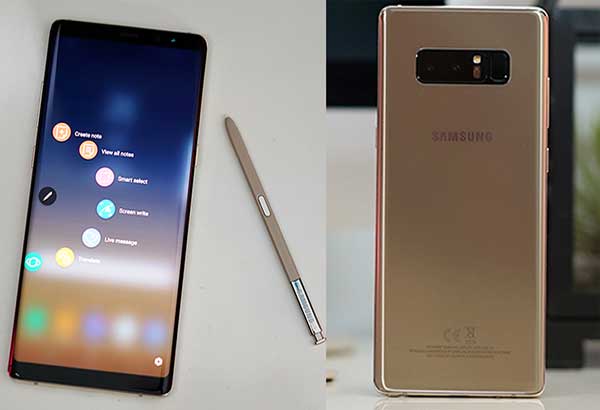Samsung Galaxy Note8 is gorgeous

Samsung gets bolder with its Samsung Galaxy Note8
When Samsung makes a comeback, it does so without much fanfare. It just shows you the best and the greatest device it can muster – just like the recently launched Galaxy Note8.
Sure, we’ve already seen and held the Galaxy S8 and S8+, and it is no surprise that the same design DNA has been infused in the Note8. But, as with all other Galaxy Notes before it, the Note8 will always embody Samsung’s biggest and boldest moves.
So yes – a gorgeous 6.3-inch Infinity Display is packed in a manageable form factor. It’s slightly taller and wider than the 6.2-inch Galaxy S8+ but the Note8 carries with it a unique companion – the S Pen stylus.
There are also tell-tale signs that Samsung was much more careful with pushing the boundaries this time, lest they end up with the same fate as last year.
Design
While sharing the same design signature as the Galaxy S8 and S8+, the Note8 is a huge jump from last year’s Galaxy Note7.
The extra-large 6.3-inch display is a significant improvement from the 5.7-inch display of the Note7, all the while maintaining a sleek profile and handy form factor. The Note8 is also noticeably thicker by about a millimeter (7.9mm for Note7, 8.1mm for S8+, 8.6mm for Note8) which is perhaps a way to address the concerns about battery safety. The Note8 is significantly heavier too at 195 grams compared to the 169 grams of the Note7.
Despite its size, the rounded corners and tapered edges make the Note8 still easy to use with one hand. The solid metal frame gives way to an all-glass front and back panel, both protected by Gorilla Glass 5 – the best the industry currently offers.
The power button is on the right, volume controls on the left along with the dedicated Bixby button, noise-canceling microphone up top together with the SIM card slot. The USB Type-C charging port at the bottom sits beside the 3.5mm audio port, primary mic, speaker grills and the slot for the S Pen.
The back is flat with tapered edges to help with better grip. It’s glossy and slippery on the hands with an equally smudge-prone surface as the front.
In the middle is the camera module, which houses a pair of 12-megapixel sensors. The primary one has the same optics as the Galaxy S8 that features a wide f/1.7 aperture while the second one has a telephoto lens that offers 2x optical zoom paired with a dual-tone, dual-LED flash.
The fingerprint sensor, which doubles as a heart-rate sensor, is just beside the camera module, a placement originally introduced with the S8 but did not sit well with us in terms of ergonomics.
The Note8 still features the same IP68 dust and water-resistance that allows it to be soaked in water in a depth of 1.5 meters up to 30 minutes. Not that we recommend you to take this phone for a swim but more like an assurance that any contact with water for some considerable amount of time isn’t going to be a serious concern.
The S Pen stylus comes in very handy for those who are heavy note-takers and artists who love to draw or sketch a lot. Accuracy and pressure sensitivity is next to nothing.
Display
Smartphone display has always been Samsung’s biggest strength since the very first Galaxy Note. Samsung produces its own panels and has access to their Super AMOLED technology, which makes it one of their best selling points.
The Note8 sports a massive 6.3-inch Super AMOLED display with a 1440 x 2960 pixel resolution (WQHD+) and an unusual aspect ratio of 18.5:9.
This is the same aspect ratio first introduced in the Galaxy S8/S8+, and is achieved by shaving off additional screen real estate at the top and bottom bezels. Together with the curved edges, the front panel leaves almost nothing but a seemingly endless infinity display.
A couple of years back, a mobile device with a 6.3-inch display could have been considered tablet territory with seven inches as the sweet spot. The Galaxy Note8 breaks that notion, pushing the screen-to-body ratio at 83 percent.
Camera
While it took some time for Samsung to get into the dual-camera game, its first attempt is with the Note8.
Both cameras have 12-megapixel sensors with the primary one having inherited the same optics used on the Galaxy S8 – a wide f/1.7 aperture, phase-detection autofocus, optical image stabilization, auto HDR and 4K recording at 30fps.
The secondary camera features a similar 12MP sensor with f2.4 aperture, 52mm focal length, and 2x optical zoom. Using its built-in optical image stabilization, the camera can zoom in at a maximum of 10x (digital) zoom and still manage to capture really smooth and almost shake-free image.
Samsung added a few tricks as well like Live Focus, which allows the user to adjust the subject in focus and the level of blur in the background even after the photo has been taken.
At the front is the selfie camera, capable of taking 8MP stills and 1440p video even in low-light conditions, thanks to its wide f/1.7 aperture.
Performance
Samsung used the same Exynos 8895 chip they placed in the Galaxy S8 to the Note8. It’s an octa-core processor that uses two clusters of quad-core processors working in tandem to provide high-performance computing power when needed and then switches to the power-efficient cores when on idle or not doing heavy tasks, apparently to help conserve battery life.
We’ve seen and observed how the Exynos 8895 performed in the Galaxy S8 that we’ve been using since it was released back in May and during the entire time we have never had any issues with it.
It’s fast and powerful, can smoothly run multiple apps at the same time yet remain very responsive.
Samsung added more memory, 50 percent more to be exact, on the Galaxy Note8. It’s not the first Samsung smartphone to have 6GB of RAM (the Galaxy C9 Pro took that title) but we think it’s high time for Samsung did just the same.
To further improve performance, Samsung used UFS 2.1 storage for the Note8. This means faster read and write speeds to the internal storage which can be greatly useful when recording 4K videos or moving large amounts of files. So far, we observed a 15-percent improvement in write speeds on the Note8 compared to the S8 in our benchmarks (171MB/s -> 203MB/s).
Battery Life
Battery life is a touchy subject considering the fate of the Galaxy Note7 last year. This year, Samsung is being extra careful, and this is evident in the way they treated the Note8.
First, they sacrificed a little bit on the thickness of the device. The Note7 had a very thin 7.9mm profile while the Note8 this year is slightly thicker at 8.6mm. That extra 0.7mm gives more room for the built-in battery to breathe.
Second, they reduced the total capacity of the battery from 3,500mAh (on the Note7) to just 3,300mAh on the Note8. It’s a shame, though, since even the Galaxy S8+ had a 3,500mAh battery.
The move is perfectly understandable, given the circumstances and history of the Note7. It’s a small sacrifice in exchange for safety. That’s to be expected if they want to regain the trust of their customers.
Despite the lower battery capacity, the Note8 managed to do well in our battery tests -- clocking in about 17 hours of continuous video playback on a single full charge. In our daily use, the Note8 easily lasts more than an entire day, but that heavily depends on individual usage patterns.
Of course, the Note8 also supports ultra-fast charging (50-60 minutes) for wired and fast charging for wireless (70-80 minutes).
Conclusion
The Galaxy Note8’s comeback is measured and calculated. They pushed the boundaries a little bit here and there. A bigger display, dual-camera setup and unified design signature are the main focus points.
The Galaxy Note8 is undoubtedly a great device – big in size, bold in intention. If there’s one other item we’d hope to cross, that would certainly be the asking price: P49,990.
Expect the Samsung Galaxy Note8 to arrive in the Philippines by Sept. 29. Available colors are maple gold and midnight black.
Samsung Galaxy Note8 specs
6.3-inch 18.5:9 sAMOLED Infinity Display @ 2960 x 1440 pixel, 522ppi
Corning Gorilla Glass 5
Samsung Exynos 8895 2.4GHz octa-core processor
Mali-G71 GPU
6GB LPDDR4 RAM
64GB UFS 2.1 internal storage
Expandable via microSD up to 256GB (uses SIM2)
12MP f/1.7 DualPixel +12MP f/2.4 TelePhoto dual rear cameras: OIS, Dual Tone LED Flash
8MP f/1.7 front camera
4G LTE
Dual SIM, Dual Standby (hybrid)
WiFi 802.11 a/b/g/n/ac
Bluetooth 5.0
GPS with aGPS support, Galileo, GLONASS, BeiDou
NFC
Fingerprint Scanner
Iris Scanner
Heart-Rate Sensor
Face Recognition Scanner
USB Type-C
IP68 Dust and Water Resistance
S-Pen
Samsung Bixby AI
Samsung TouchWiz UI (Android 7.1.1 Nougat)
3300mAh battery (non-removable) with Fast wireless charging
162.5 x 74.8 x 8.6mm (dimensions)
195 grams (weight)
- Latest






























